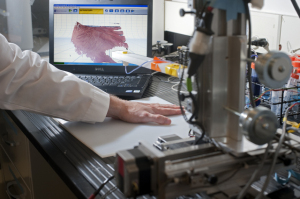Inkjet-like Device Prints Skin Cells Over Burns
by
Heather Mayer, DOTmed News Reporter | April 20, 2010

A laser scans the wound
to create a map, so that
the correct type and number
of cells can be placed
precisely as needed
As an alternative to skin grafting, researchers at Wake Forest University have found a way to spray skin cells onto burn wounds using an inkjet-like printer for a less-painful, speedy recovery.
This procedure, which is still in the early experimental stages, could be a big advance in treating burn wounds early and effectively, researchers said.
"If the technology is successful, its benefits will be to quickly cover a burn wound and promote healing," said researcher Anthony Atala, M.D. researcher and director of the Wake Forest Institute for Regenerative Medicine, in an e-mail to DOTmed News.
Printing skin cells onto a patient's wounds works very similarly to regular inkjet printing, which is where the idea stemmed from.
"The idea of using printers to make tissue has been around for a long time, but the science was not yet ready for the creation of functional tissues and organs until recently," said Dr. Atala. "For one of our techniques, we use an inkjet printer, but instead of using ink in the cartridge to print on paper, we use cells to print tissues and organs in a three-dimensional shape."
The technique starts with drawing the organ or tissue that will be printed using a PowerPoint-like program. The cells that will be used for printing are stored in reserves, not unlike ink cartridges stored in a printer, Atala said. In this particular experiment, a laser scans the wound to determine its size and depth, which creates a map of the wound. A computer then controls the release of the cells from the reserves as they are printed onto the wound.
"The wound map is used as a guide so that the correct type and number of cells can be precisely placed on the wound," Atala explained.
The guinea pigs of this experiment have only been mice, with similar burn wounds one would see on a person. The researchers look ahead to testing this technology on pigs, which have more similar skin to humans.
Using this bio-printing method, burn wounds on the mice healed in just three weeks, Atala said. Animals that did not receive this type of treatment healed in five weeks. Victims of massive burns tend to die of infection within two weeks unless they receive skin grafts, Reuters reported.
Skin cells are taken from several places, Atala said, including cells from the patient, or a skin cell bank or stem cells from amniotic fluid or the placenta.
"As we move forward, we'll be working to determine the most effective source of cells," he said.
Atala and his team see this technology doing wonders on the battlefield, when it comes to treating wounded soldiers who often have to undergo painful skin grafting. He pointed out that burn injury is a common cause of death on the battlefield, with 10 to 30 percent of all casualties.
"Current treatment options are unable to fully address the needs of combat burn care," he said. "With traditional skin grafts, many burn patients don't have enough unburned skin to harvest grafts. A new approach is needed immediately to stabilize the wound and promote healing."
While no risks have become evident yet, there is still testing and experimenting to be done. The researchers aren't seeking FDA approval for their technology quite yet, as it is still in the development stage.
"Science takes many unexpected turns and twists, some that speed things up and others that slow things down," Atala said.
